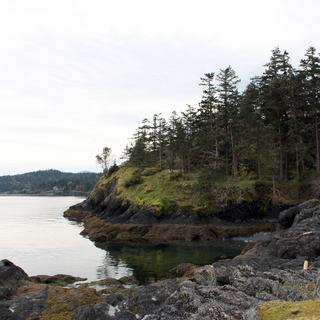A BioBlitz is a method used to collect as much information as possible, in a short amount of time, about the biodiversity and species richness of flora and fauna species in a given area. The BioBlitz that occurred on April 22, 2017 in the Mount Arrowsmith Biosphere Region (MABR) involved local experts, participants, and volunteers undertaking two sessions, a morning and afternoon, to explore the BioBlitz location and identify as many species of flora and fauna as they could. The second annual MABR BioBlitz was a little different from last year – there were two locations, one of which involved a marine survey! There was a BioBlitz for new blitzers, with the help of experts, at Milner Gardens & Woodland in Qualicum Beach and a BioBlitz for experienced blitzers at Oak Leaf Drive Park in Nanoose Bay. Both BioBlitz locations had great success this year!
I got to take part as the bird expert’s helper for the day at Milner Gardens & Woodlands! Although I was there to help people identify birds, I found that the majority of our participants were already extremely knowledgeable and did not need my help! Since I was not leading as much as I thought I would be I really got to enjoy birding and trying to find as many species as we could; in the morning session alone, we identified 49 different species of birds! We spent the first half of each session down by the waterfront looking at marine birds and then spent the rest of our time in the forest finding the song birds. Volunteers that were in the orientation area called in a barred owl; unfortunately, the birding group was not in right place at the right time and missed seeing it! Later in the afternoon we did try and find it again, but we did not have any luck! All in all, the day was a great success and we all had a lot of fun!
The Milner Gardens & Woodland BioBlitz participants found 171 different flora species, including 10 tree species, 17 shrub species, 35 herb species, 6 fern species, 3 sedge species, 1 grass species, 40 moss species, 11 liverwort species, 24 lichen species, 22 fungi species, 1 slime mold species and 1 oddball species. Amongst all of the flora species, there was 1 endangered species found, small-flowered lipocarpha. Additionally, the Bioblitz participants identified 4 different invasive flora species, including English holly, Himalayan blackberry, ox-eye daisy and yellow flag iris. Aside from all of the flora, 62 fauna species were identified, including 3 birds of prey species, 4 species of shore birds, 20 waterfowl species, 33 species of forest birds, 1 banana slug and 1 red-backed salamander. Of the 62 species of fauna, there were 4 on the species at risk list, 1 considered threatened, the marbled murrelet, and the other 3 were of special concern, including band-tailed pigeon, horned grebe and western grebe.
The Oak Leaf Drive Park BioBlitz, was a much smaller location, but had two elements, terrestrial and marine. In the terrestrial survey, participants identified 3 tree species, 4 shrub species, 37 herb species, 1 fern species, 1 sedge species, 2 species of rushes, 5 grass species, 3 moss species, 3 liverwort species, 2 lichen species and 3 species of fungi. Of the 64 flora species found, the participants identified two invasive species, Canada thistle and hairy cat’s ear. Additionally, there were 16 species of fauna found, including 1 species of shore birds, 2 waterfowl species, 12 species of forest birds and a banana slug. The marine survey at Oak Leaf Drive Park found a huge diversity of species, including 5 species of kelp, 3 sponge species, 3 species of tube worms, 4 tunicate species, 11 cnidarian species, 7 gastropoda species, 3 bi-valve species, 1 species of barnacle, limpets and chitons, 7 species of crustaceans, 17 echinoderm species, 9 fish species, 1 cephalopod species and 1 mammal species. Of the 74 species, 2 are listed as Species at Risk; one species, the northern abalone is listed as endangered and the other, the quillback rockfish, is listed as threatened.
All the data collected by participants, experts and volunteers has added to the initial baseline data from last year’s BioBlitz in Milner Gardens & Woodlands and created baseline data for Oak Leaf Drive Park. Having a BioBlitz each year will be beneficial to monitor any changes in the presence of red and blue listed species, invasive species and the general biodiversity in these regions. Monitoring the presence or absence of species in the MABR is becoming more important with the intensifying effects of climate change!




